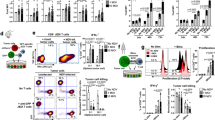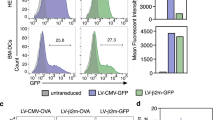Abstract
CD4+ T helper cells are known to play an integral role in the generation of CD8+ T-cell immune responses. We have previously shown that co-administration of DNA vaccines containing E6 or E7 protein of human papillomavirus 16 (HPV-16) combined with DNA encoding invariant (Ii) chain in which class II-associated Ii peptide (CLIP) region is replaced with the CD4+ T helper epitope, PADRE (Pan-DR-epitope) (Ii-PADRE DNA) enhanced HPV antigen-specific CD8+ T-cell immune responses in vaccinated mice. In the current study, we investigated the enhancement of HPV E7-specific CD8+ T-cell immune responses by PADRE-specific CD4+ T cells. We showed that intradermal administration of Ii-PADRE DNA at the same location as E7-expressing DNA is necessary to generate strong E7-specific CD8+ T-cell immune responses. We also showed that PADRE-specific CD4+ T cells generated by Ii-PADRE DNA vaccination expressed Th1 cytokine profile. Furthermore, our in vitro study demonstrated that PADRE-specific CD4+ T cells stimulated with PADRE-loaded dendritic cells secrete IL-2 that leads to the proliferation of E7-specific CD8+ T cells. Thus, our data suggest that activated PADRE-specific CD4+ T helper cells may be required at the vicinity of E7-specific CD8+ T cells where they secrete IL-2, which enhances the E7-specific CD8+ T-cell immune responses generated by DNA vaccination.
This is a preview of subscription content, access via your institution
Access options
Subscribe to this journal
Receive 12 print issues and online access
$259.00 per year
only $21.58 per issue
Buy this article
- Purchase on Springer Link
- Instant access to full article PDF
Prices may be subject to local taxes which are calculated during checkout






Similar content being viewed by others
References
Donnelly JJ, Ulmer JB, Shiver JW, Liu MA . DNA vaccines. Annu Rev Immunol 1997; 15: 617–648.
Gurunathan S, Klinman DM, Seder RA . DNA vaccines: immunology, application, and optimization. Annu Rev Immunol 2000; 18: 927–974.
Condon C, Watkins SC, Celluzzi CM, Thompson K, Falo Jr LD . DNA-based immunization by in vivo transfection of dendritic cells. Nat Med 1996; 2: 1122–1128.
Porgador A, Irvine KR, Iwasaki A, Barber BH, Restifo NP, Germain RN . Predominant role for directly transfected dendritic cells in antigen presentation to CD8+ T cells after gene gun immunization. J Exp Med 1998; 188: 1075–1082.
Hung CF, Wu TC . Improving DNA vaccine potency via modification of professional antigen presenting cells. Curr Opin Mol Ther 2003; 5: 20–24.
Tsen SW, Paik AH, Hung CF, Wu TC . Enhancing DNA vaccine potency by modifying the properties of antigen-presenting cells. Expert Rev Vaccines 2007; 6: 227–239.
Castellino F, Germain RN . Cooperation between CD4+ and CD8+ T cells: when, where, and how. Annu Rev Immunol 2006; 24: 519–540.
Hung K, Hayashi R, Lafond-Walker A, Lowenstein C, Pardoll D, Levitsky H . The central role of CD4(+) T cells in the antitumor immune response. J Exp Med 1998; 188: 2357–2368.
Marzo AL, Kinnear BF, Lake RA, Frelinger JJ, Collins EJ, Robinson BW et al. Tumor-specific CD4+ T cells have a major ‘post-licensing’ role in CTL mediated anti-tumor immunity. J Immunol 2000; 165: 6047–6055.
Hung CF, Tsai YC, He L, Wu TC . DNA vaccines encoding Ii-PADRE generates potent PADRE-specific CD4(+) T-cell immune responses and enhances vaccine potency. Mol Ther 2007; 15: 1211–1219.
Lin KY, Lu D, Hung CF, Peng S, Huang L, Jie C et al. Ectopic expression of vascular cell adhesion molecule-1 as a new mechanism for tumor immune evasion. Cancer Res 2007; 67: 1832–1841.
Mitchison NA, O'Malley C . Three-cell-type clusters of T cells with antigen-presenting cells best explain the epitope linkage and noncognate requirements of the in vivo cytolytic response. Eur J Immunol 1987; 17: 1579–1583.
Bennett SR, Carbone FR, Karamalis F, Miller JF, Heath WR . Induction of a CD8+ cytotoxic T lymphocyte response by cross-priming requires cognate CD4+ T cell help. J Exp Med 1997; 186: 65–70.
Bousso P, Robey E . Dynamics of CD8+ T cell priming by dendritic cells in intact lymph nodes. Nat Immunol 2003; 4: 579–585.
Bevan MJ . Helping the CD8(+) T-cell response. Nat Rev Immunol 2004; 4: 595–602.
Xiang J, Huang H, Liu Y . A new dynamic model of CD8+ T effector cell responses via CD4+ T helper-antigen-presenting cells. J Immunol 2005; 174: 7497–7505.
Keene JA, Forman J . Helper activity is required for the in vivo generation of cytotoxic T lymphocytes. J Exp Med 1982; 155: 768–782.
Cassell D, Forman J . Linked recognition of helper and cytotoxic antigenic determinants for the generation of cytotoxic T lymphocytes. Ann NY Acad Sci 1988; 532: 51–60.
Alexander J, Sidney J, Southwood S, Ruppert J, Oseroff C, Maewal A et al. Development of high potency universal DR-restricted helper epitopes by modification of high affinity DR-blocking peptides. Immunity 1994; 1: 751–761.
Lin K-Y, Guarnieri FG, Staveley-O'Carroll KF, Levitsky HI, August T, Pardoll DM et al. Treatment of established tumors with a novel vaccine that enhances major histocompatibility class II presentation of tumor antigen. Cancer Res 1996; 56: 21–26.
Shen Z, Reznikoff G, Dranoff G, Rock KL . Cloned dendritic cells can present exogenous antigens on both MHC class I and class II molecules. J Immunol 1997; 158: 2723–2730.
Ji H, Wang T-L, Chen C-H, Hung C-F, Pai S, Lin K-Y et al. Targeting HPV-16 E7 to the endosomal/lysosomal compartment enhances the antitumor immunity of DNA vaccines against murine HPV-16 E7-expressing tumors. Hum Gene Ther 1999; 10: 2727–2740.
Hung CF, Tsai YC, He L, Coukos G, Fodor I, Qin L et al. Vaccinia virus preferentially infects and controls human and murine ovarian tumors in mice. Gene Ther 2007; 14: 20–29.
Cheng WF, Hung CF, Chai CY, Hsu KF, He L, Ling M et al. Tumor-specific immunity and antiangiogenesis generated by a DNA vaccine encoding calreticulin linked to a tumor antigen. J Clin Invest 2001; 108: 669–678.
Chen CH, Wang TL, Hung CF, Yang Y, Young RA, Pardoll DM et al. Enhancement of DNA vaccine potency by linkage of antigen gene to an HSP70 gene. Cancer Res 2000; 60: 1035–1042.
Acknowledgements
We gratefully acknowledge Dr Richard Roden for helpful discussions and critical review of the manuscript and Ms Talia Hoory for assistance in preparation of the manuscript. This study was supported by the Flight Attendant Medical Research Institute Young Clinical Scientist Award, the National Cancer Institute SPORE in Cervical Cancer P50 CA098252 and the 1 RO1 CA114425-01.
Author information
Authors and Affiliations
Corresponding author
Additional information
Supplementary Information accompanies the paper on Gene Therapy website (http://www.nature.com/gt)
Supplementary information
Rights and permissions
About this article
Cite this article
Kim, D., Monie, A., He, L. et al. Role of IL-2 secreted by PADRE-specific CD4+ T cells in enhancing E7-specific CD8+ T-cell immune responses. Gene Ther 15, 677–687 (2008). https://doi.org/10.1038/sj.gt.3303102
Received:
Accepted:
Published:
Issue Date:
DOI: https://doi.org/10.1038/sj.gt.3303102
Keywords
This article is cited by
-
Innovative DNA vaccine for human papillomavirus (HPV)-associated head and neck cancer
Gene Therapy (2011)
-
Pitfalls of vaccinations with WT1-, Proteinase3- and MUC1-derived peptides in combination with MontanideISA51 and CpG7909
Cancer Immunology, Immunotherapy (2011)
-
Therapeutic HPV DNA vaccines
Immunologic Research (2010)
-
Enhancement of CD4+ T-cell help reverses the doxorubicin-induced suppression of antigen-specific immune responses in vaccinated mice
Gene Therapy (2008)



